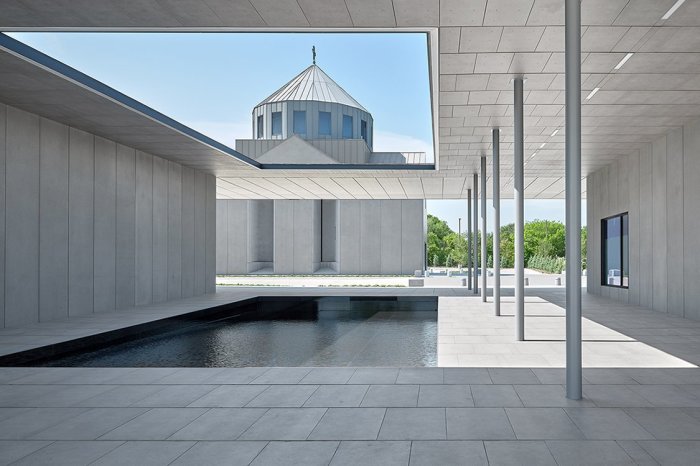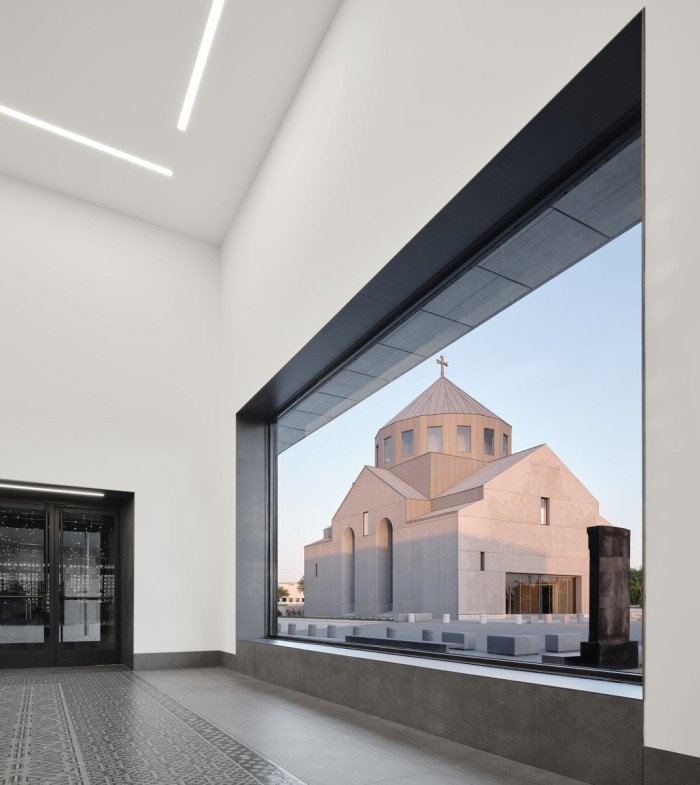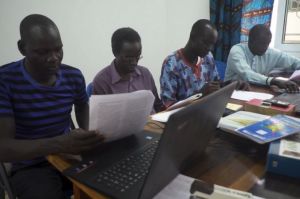The Armenian Genocide and architecture: How they intersect

Architecture is silent, yet it has something to teach us. We are told that we are hopelessly fragmented by ideology and identity into unreconcilable categories, separated by rifts that cannot be bridged. But architecture silently fuses these dualities. Architecture is always both conservative and progressive, bridging between past and future, between ancient precedent and emerging innovation, between the individual and the collective. In fusing these contradictions architecture provides the space in which divisions, within a society or even within an individual, can coexist and even cohere, in which the imagined past and the imagined future withdraw into the experienced present.
My experience designing a church in the north Dallas suburb of Carrollton Texas provides a picture of how this merger of opposites can take place. This building complex – the Saint Sarkis Armenian Church and Community Center – completed in 2022 for a parish that had been meeting in a converted house since it was founded thirty years ago, was honored on April 12 by the New York Chapter of the American Institute of Architects with its highest annual accolade for new buildings, the AIA Honor Award for Architecture. Two weeks later, on April 24th, members of the congregation joined Armenians worldwide in observing the annual commemoration of the 1915 genocide.
How does this all connect? How does a suburban Texas church tie to these musings about the unifying power of architecture? Or to the first modern genocide? I hope my explanation might change the way you understand the silent language of buildings.
Many members of the St. Sarkis community are descended from ancestors born in the ancient Armenian homeland that once surrounded Mount Ararat, where Noah’s Ark is said to have come to rest, and where Armenians established the first Christian nation in 301 AD, 80 years before the Roman Empire converted to Christianity.
Many of the parishioners’ parents or grandparents were among the tiny remnant from the million-strong Armenian community who survived the Armenian Genocide of 1915, in which the entire Armenian population of eastern Anatolia was eradicated as the modern state of Turkey was being established at the end of the First World War. The young men were executed, and the women, children, and the elderly were driven into the Syrian desert where more than a million perished from thirst, hunger, exhaustion, and exposure in the prototypical modern act of genocide, involving, in this case, the systematic erasure of an indigenous population.
A small remnant managed to cross into Lebanon, where an Armenian community was established in Beirut. When the Lebanese civil war broke out in the 1970s, some of these descendants emigrated to the United States, including the primary patron of St. Sarkis, who studied engineering, established a series of successful businesses, and dedicated himself to building the church for this North Dallas congregation, and who introduced me — a non-Armenian architect — into the equation.

Just as people can be divided by ideology, architecture can be simplified into stylistic camps. The crudest simplification pits architects who are inspired by visions of the past and adhere to traditional forms and models against those driven by a vision of the future, who push aesthetic and technological boundaries. This cleavage is often grossly simplified to mirror the political rift between progressives and conservatives. But architecture, like life, is more complex and more unified. Most of us seek both a connection to the past and a vision that embraces the future.
The patron of the Saint Sarkis Church was seeking an architectural expression that would demonstrate unwavering respect for the deep legacy of Armenian church building while standing squarely in the present and looking toward a future of regeneration and renewal. The Church of Saint Sarkis exemplifies this more complex unity. At first, the design of St. Sarkis might seem deeply conservative, for the scale, proportions, and sculptural massing of the new building are modeled directly on the ancient church of St Hripsime, completed in 618 AD, which still stands in the modern-day Republic of Armenia, in the mountainous fragment of the original Armenian homeland that still survives to the east of Turkey. This ancient building serves as a symbol of the perseverance and continuity of Armenian traditions having sheltered congregations across 1,400 years of seismic instability and civilizational conflict between neighboring empires.
But on closer inspection, the building reveals an equally unequivocal engagement with emerging technologies and with a focus not on the past or future but on the immediate present of experience.
The main façade of the church, spanned by the distinctive branching arms of an Armenian cross, is clad in digitally printed porcelain panels. As the visitor moves toward it, the cross is revealed to be composed of traditional interwoven decorative patterns. As the visitor moves still closer, these patterns themselves dissolve into millions of tiny but visibly unique shapes — 1.5 million of them in total— this vast variety generated by a computer script.
Why that number? Each individual shape memorializes one of the 1.5 million individuals who once made up the indigenous Armenian population of eastern Anatolia who perished in the genocide. The approach to this façade is an experience that can only emerge within a first-person, present-tense encounter as the tiny memorials surface at the threshold of legibility, filling the window of vision, providing a visceral encounter with the enormity of loss. At the first Sunday service, on April 24, 2022, I was deeply moved to see the descendants of those lost in the genocide, touching the western façade of the church, finding some solace at this memorial to their lost ancestors under the bright Texas sun.

The interior is also conservative, respectful of precedent and tradition, creating a luminous sheath of space that mirrors the interior volume of the ancient sanctuary of St. Hripsime. But it, too, employs innovative materials and progressive fabrication technologies to draw the visitor into the present. Doubly-curved vaults were fabricated in glass-fiber-reinforced gypsum directly from our computer models. Concave glass-fiber-reinforced concrete light coves sculpted into the exterior filter out solar heat and glare while reflecting the powerful Texas sunlight indirectly into the interior space, resulting in an ethereal quality of illumination. Within the interior, the materials themselves recede and the enveloping figure of empty space itself, carrying the memory of an ancient sanctuary, emerges as the primary focus of the design.
Even as it envelops the visitor in the memory of the 1400-year-old archetype, this spatial design draws inspiration from American artists of the 1960s and 1970s — James Turrell, whose medium is light, and the sculptor Robert Morris, whose work captures the deeply subjective nature of spatial experience. By shaping architectural space as a unified figure, my work endeavors to situate people as individuals within the present moment, where light has presence and the enveloping space shifts within the individual point of view, within the locus where our singular identity resides most vividly, awakening the visitor to the miracle of their individual awareness in the present.
The present is situated at the meeting of past and future, at the place, one might argue, where past and future, conservative and progressive perspectives meet within the singular eternal moment in which we exist in time.
This awakening in the present has a particularly powerful effect on a community that has endured such profound historical trauma. For the Armenian community, this sense of suspension in the present is still more intense, as the historical trauma of the 1915 genocide is being renewed and perpetuated in the present day.
In September 2020, at the very moment when the façade memorializing the 1915 Genocide was being installed on the St. Sarkis Church, Azerbaijan, supported by Turkey, renewed the program of driving Armenians from what remains of their ancient homeland by attacking the disputed enclave of Artsakh, also known as Nagorno-Karabakh. By the time the first Christmas was celebrated in St. Sarkis in the winter of 2022, Azerbaijan had imposed a blockade on Artsakh, cutting off food and fuel during the dead of winter, timed to inflict maximum hardship during the Christmas season. Last September, when the blockade had been in place for a year, Azerbaijan attacked again, overwhelming the isolated Armenian population and violently expelling all 120,000 indigenous Armenians into exile. By the time the St. Sarkis Church celebrated its second Christmas, another fragment of the Armenian homeland had been violently emptied of its indigenous inhabitants. Thousands of years of Armenian culture are currently being erased, from place names, churches, ancient monasteries, and burial sites, in the full light of day, in 2024.
As the Saint Sarkis Armenian Church is recognized for an Honor Award in Architecture, I feel an obligation to raise the awareness, of both progressives and conservatives, to a historic genocide reborn in the present, to the ethnic cleansing of an indigenous population, to the persecution and dispossession of this surviving remnant of the very first Christian nation on earth, underway at this very moment, in 2024.
David Hotson is an award-winning architect based in New York City.




























